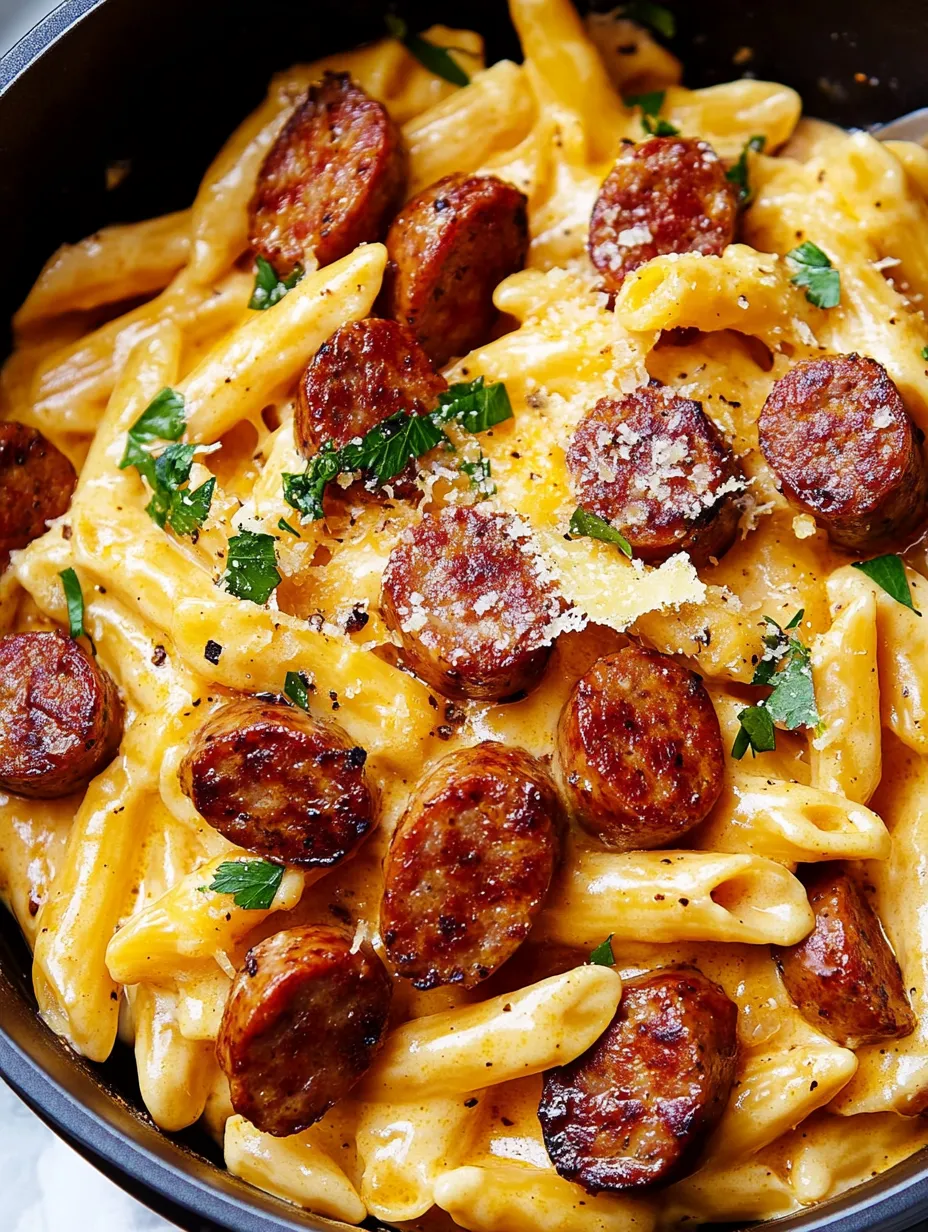 Pin it
Pin it
This smoked sausage Cajun Alfredo brings together the bold, spicy flavors of Louisiana cuisine with the creamy indulgence of classic Italian pasta. The smoky depth of sausage mingles with the rich Alfredo sauce, while Cajun seasoning adds just the right amount of heat and complexity. Each forkful delivers the perfect balance of textures and flavors - tender pasta, savory sausage, and silky sauce that clings to every bite. Ready in just minutes yet packed with restaurant-quality taste, this dish proves that extraordinary flavors don't require complicated techniques or hours in the kitchen.
I discovered this recipe during a particularly busy week when I needed to put dinner on the table quickly but didn't want to sacrifice flavor. The first time I made it, my husband declared it 'restaurant quality' and asked how long I'd been hiding this recipe from him. What surprised me most was how the simple combination of smoked sausage and Cajun seasoning transformed regular Alfredo pasta into something completely different from our usual rotation. The contrast between the smoky, spicy sausage and the creamy, mellow sauce creates a combination that feels special even though it comes together in minutes.
Ingredients You'll Need
- 1 package (14 oz) Smoked Sausage: Creates the hearty, smoky foundation of the dish. Slicing it into ¼-inch rounds ensures even cooking and proper distribution.
- 8 ounces Pasta: Holds the creamy sauce perfectly. Fettuccine is traditional, but penne or rotini work beautifully too.
- 2 cups Heavy Cream: Forms the rich base of the Alfredo sauce. The high fat content creates that silky-smooth texture.
- 1 tablespoon Cajun Seasoning: Provides the signature spicy flavor profile. Adjust amount according to your heat preference.
- ½ cup Parmesan Cheese, freshly grated: Adds salty depth and thickens the sauce. Pre-grated won't melt as smoothly as freshly grated.
- Fresh Parsley, chopped (optional): Adds a pop of color and fresh flavor that brightens the rich dish.
- Salt and Black Pepper: For final seasoning adjustments. Add carefully as the Cajun seasoning already contains salt.
 Pin it
Pin it
Step-by-Step Cooking Instructions
- Prepare the Pasta:
- Begin by bringing a large pot of salted water to a rolling boil. Add your pasta of choice and cook according to package directions until al dente – tender but still firm to the bite. This texture is crucial as the pasta will continue to absorb sauce after cooking. Before draining, reserve about ½ cup of the starchy pasta water to help adjust the consistency of your sauce later if needed. Drain the pasta in a colander but don't rinse it – the starch on the surface helps the sauce adhere better.
- Crisp the Sausage:
- While the pasta cooks, slice your smoked sausage into ¼-inch thick rounds. Heat a large, deep skillet over medium-high heat (no oil needed as the sausage will release its own fat). Add the sliced sausage to the hot skillet and cook for 3-4 minutes, stirring occasionally, until the edges become crispy and caramelized. This step is crucial for developing deep flavor – those browned bits will infuse the entire sauce with smoky goodness. If there's excessive fat rendered, you can drain some off, but leave about a tablespoon in the pan for flavor.
- Create the Creamy Base:
- Reduce the heat to medium and carefully pour the heavy cream into the skillet with the sausage. The cream may sputter slightly when it hits the hot pan, so pour slowly. Add the Cajun seasoning and stir to combine, making sure to scrape up any browned bits from the bottom of the pan – these contain concentrated flavor that will enrich your sauce. Bring the mixture to a gentle simmer, being careful not to let it reach a full boil which could cause the cream to separate.
- Develop the Sauce:
- Allow the cream and sausage mixture to simmer gently for 3-4 minutes, stirring occasionally. During this time, the sauce will begin to thicken slightly and the Cajun spices will infuse the cream. The color will change from pure white to a light orange-pink hue as it takes on the seasonings. If the sauce reduces too quickly or becomes too thick, lower the heat slightly or add a splash of the reserved pasta water to maintain the desired consistency.
- Incorporate the Cheese:
- Remove the skillet from the heat and immediately add the freshly grated Parmesan cheese. Stir continuously until the cheese melts completely and incorporates into the sauce, creating a smooth, silky texture. The residual heat from the sauce should be enough to melt the cheese without causing it to become stringy or grainy. Taste the sauce and adjust the seasoning with salt and black pepper if necessary, remembering that Parmesan adds saltiness.
- Combine and Finish:
- Add the drained pasta directly to the skillet with the sauce and toss gently until every strand is thoroughly coated. If the sauce seems too thick, add a splash of the reserved pasta water to loosen it to your desired consistency. The starch in the pasta water helps the sauce cling to the pasta rather than simply thinning it out. For the final touch, sprinkle with chopped fresh parsley if desired, which adds a pop of color and fresh flavor that balances the richness of the dish.
- Serve Immediately:
- Transfer the pasta to warmed serving plates or bowls and serve immediately while the sauce is still silky smooth and the pasta is hot. This dish is best enjoyed fresh from the skillet, when the contrast between the al dente pasta and the creamy sauce is at its peak. For an extra touch of indulgence, offer additional grated Parmesan at the table for those who want to add more cheesy goodness.
I learned the importance of properly caramelizing the sausage after my first attempt at this recipe resulted in a somewhat bland sauce. Now I make sure to cook the sausage until it develops those beautiful crispy edges – the flavor difference is remarkable. Another game-changing discovery was the impact of freshly grated Parmesan versus pre-grated. The first time I used freshly grated, the sauce was noticeably silkier and had a more pronounced cheese flavor. These small adjustments transformed a good dish into a truly exceptional one that's now in our regular dinner rotation.
Perfect Pairings
This rich pasta dish pairs beautifully with lighter sides that balance its creamy decadence. A simple green salad with a vinaigrette dressing cuts through the richness perfectly, while roasted asparagus or broccoli adds a nutritional boost and contrasting texture. For bread lovers, a crusty piece of garlic bread makes the ideal tool for scooping up any remaining sauce. A chilled glass of crisp white wine like Sauvignon Blanc or a light beer complements the spicy notes of the Cajun seasoning.
Variation Ideas
This versatile recipe welcomes creative modifications. For seafood lovers, substitute or add shrimp for a classic Cajun twist – add them in the last few minutes of cooking the sauce to prevent overcooking. To increase the vegetable content, sauté bell peppers, onions, and mushrooms with the sausage. For extra heat, add a dash of hot sauce or red pepper flakes. You can also experiment with different proteins – chicken, Andouille sausage, or even crawfish all work beautifully with these flavors.
Make-Ahead Tips
While this dish is best enjoyed fresh, you can prepare components ahead of time to streamline dinner. Cook the pasta 1-2 minutes shy of al dente, toss with a bit of olive oil, and refrigerate. The sausage can be sliced and stored in an airtight container. When ready to serve, warm the sausage in the skillet, make the sauce, and add the pre-cooked pasta to heat through. The sauce may need extra pasta water to reach the right consistency since the refrigerated pasta will absorb some of the liquid.
 Pin it
Pin it
Troubleshooting Common Issues
If your sauce becomes too thick, simply add a splash of pasta water or cream to thin it to your desired consistency. If it's too thin, continue simmering gently until it reaches the right thickness – it will also thicken slightly as it cools. Should your sauce appear curdled or separated, lower the heat immediately and whisk in a tablespoon of cold cream to help it re-emulsify. Remember that the sauce will continue to thicken as it stands, so it's better to err on the side of slightly too thin than too thick.
I've made this dish countless times, and I've found that the quality of your smoked sausage makes a significant difference in the final result. After experimenting with various brands, I now look for sausage with visible spices and a firm texture that holds its shape during cooking. Another revelation was discovering how much the pasta shape affects the eating experience - my family prefers fusilli or rotini because the spiral shape captures more of the delicious sauce in every bite. These personal touches have helped make this recipe uniquely ours, and I encourage you to find your own favorite variations!
Frequently Asked Questions
- → What pasta works best with this recipe?
- Fettuccine is traditional for Alfredo, but any medium pasta shape works well - try penne, rotini, or farfalle to catch the creamy sauce in their ridges and curves.
- → Can I make this dish less spicy?
- Absolutely! Start with just 1 teaspoon of Cajun seasoning instead of a tablespoon, then taste and adjust. You can also use a mild Cajun seasoning or make your own with less cayenne.
- → What vegetables would pair well with this dish?
- Bell peppers, onions, and mushrooms are great additions. Sauté them with the sausage for extra flavor. A side of steamed broccoli or a simple green salad also complements this rich dish nicely.
- → Can I use milk instead of heavy cream?
- For a lighter version, you can use half-and-half or whole milk, but the sauce won't be as thick. If using milk, consider adding 1-2 tablespoons of flour to help thicken the sauce.
- → Is there a way to make this dish gluten-free?
- Simply substitute your favorite gluten-free pasta. Just make sure to check that your Cajun seasoning and sausage are also gluten-free, as some brands may contain gluten as a filler.
